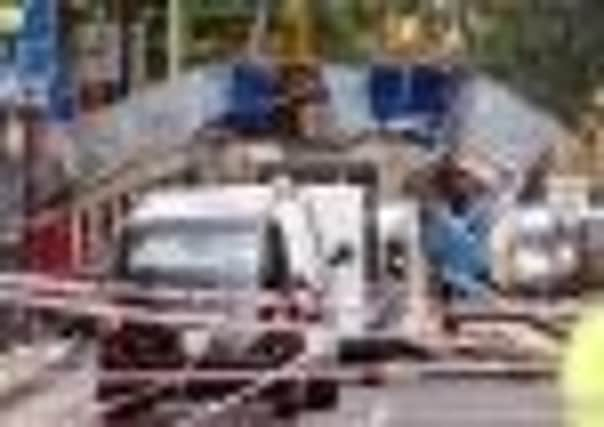July 7 verdicts: How the terror unfolded


• February 3, 1993 - Plot ringleader Mohammed Sidique Khan, then aged 18, is arrested and cautioned for an assault committed the previous Boxing Day. A police record is created and his photograph is taken.
• January 26-28, 2001 - West Yorkshire Police surveillance officers take pictures of a group of about 40 men attending a training camp in the Lake District run by two known extremists. Khan is among those photographed but he is not identified until after the 7/7 attacks.
Advertisement
Hide AdAdvertisement
Hide Ad• February 2, 2004 - Khan and 7/7 number two Shehzad Tanweer travel to Crawley, West Sussex, to meet Omar Khyam, the mastermind behind a fertiliser bomb plot. MI5 surveillance officers take a clear colour photograph of the pair at the Toddington Services on the M1 in Bedfordshire on their way home to Leeds.
• August 12, 2004 - Al Qaida supergrass Mohammed Junaid Babar is shown surveillance pictures of Khan and Tanweer, but does not identify them despite having met Khan at a terrorist training camp in Pakistan the previous year. MI5 officers do not show Babar the full picture taken in February at the motorway service station, the best image they have of Khan.
• January 17, 2005 - West Yorkshire Police receive intelligence that a committed extremist called “Saddique” from Batley, West Yorkshire, underwent training in Afghanistan in the late 1990s or early 2000s. MI5 and police fail to identify the man, but it emerges after the 7/7 bombings that he was Khan.
• February 22, 2005 - The four plotters begin stockpiling peroxide for their homemade explosives.
Advertisement
Hide AdAdvertisement
Hide Ad• May 2005 - Jermaine Lindsay rents a flat in Alexandra Grove, Leeds, for use as a bomb factory and the terrorists begin assembling their devices.
• July 7, 2005 - Khan, Tanweer, Lindsay and Hasib Hussain meet at Luton station. They take the 7.25am train to King’s Cross in London, then hug and separate to carry out their deadly missions.
Within three minutes of 8.50am, Tanweer detonates his bomb at Aldgate, Khan sets his device off at Edgware Road and Lindsay blows himself up between King’s Cross and Russell Square.
Nearly an hour later Hussain detonates his device on a number 30 bus in Tavistock Square.
Advertisement
Hide AdAdvertisement
Hide AdAs well as killing themselves and 52 others, the bombers injure more than 700 people and cause huge disruption to the capital’s transport network.
• July 12, 2005 - Officers identify CCTV images of the four bombers at Luton and King’s Cross stations.
Police raid the homes of Khan, Tanweer and Hussain in West Yorkshire, as well as their bomb factory.
• July 21, 2005 - London is again plunged into chaos after another four men launch failed attacks on Tube trains at Oval, Warren Street and Shepherd’s Bush and on a number 26 bus at Bethnal Green.
Advertisement
Hide AdAdvertisement
Hide Ad• September 1, 2005 - Middle Eastern television channel Al Jazeera broadcasts a martyrdom video recorded by Khan before his death. In the short film, the ringleader of the 7/7 attacks says: “We are at war and I am a soldier. Now you too will taste the reality of this situation.”
• May 11, 2006 - A report by the Parliamentary Intelligence and Security Committee (ISC) reveals that Khan and Tanweer were known to MI5 before the bombings but were not fully investigated because the Security Service had more pressing priorities.
The Government’s official account of the attacks, published at the same time, reveals that the operation probably cost less than £8,000 and was financed by the terrorists themselves.
• June 5, 2006 - A London Assembly review of the emergency services’ response exposes a catalogue of failings in the chaotic aftermath of the attacks.
Advertisement
Hide AdAdvertisement
Hide Ad• July 7, 2006 - Tanweer’s martyrdom video is released on the first anniversary of the attacks. In the 31-minute film, which also features al Qaida second-in-command Ayman al-Zawahiri, the bomber says: “We are 100% committed to the cause of Islam. We love death the way you love life.”
• September 22, 2006 - A Government report into the emergency response criticises the support given to bereaved families and survivors after the atrocities.
• April 28, 2009 - The only three people to be charged in connection with the 7/7 attacks are cleared of helping the bombers choose their targets after two trials at Kingston Crown Court. But Waheed Ali and Mohammed Shakil are convicted of conspiracy to attend a terrorist training camp after their arrest just before boarding a flight for Pakistan in 2007.
• May 19, 2009 - A second ISC report concludes that MI5 cannot be criticised for failing to investigate Khan fully before the 7/7 bombings because it was swamped with terror suspects at the time.
Advertisement
Hide AdAdvertisement
Hide Ad• July 7, 2009 - The Prince of Wales unveils a permanent memorial to the 52 innocent victims in Hyde Park in London on the fourth anniversary of the attacks.
• October 11, 2010 - The long-awaited inquest into the deaths of those killed in the attacks gets under way at the Royal Courts of Justice in London.
• March 3, 2011 - The inquest finishes hearing evidence.